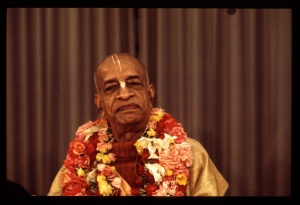720118 - Lecture Sannyasa Initiaton of Tamal Krsna - Jaipur

A.C. Bhaktivedanta Swami Prabhupada
Devotee: Evening, January 18th, Jaipur.
Prabhupāda: (recites with Tamal Kṛṣṇa and devotees repeating)
parātma, niṣṭhā, adhyā, sitāṁ, pūrva, tamair, mahadbhiḥ; ahaṁ, tariṣyāmi, duranta, pāraṁ, tamo, mukunda, aṅghri, niṣe, vayaiva. etāṁ, sam āsthāya, parātma, niṣṭhām, adhyāsitāṁ, pūrva, tamair, mahadbhiḥ; ahaṁ, tariṣyāmi, duranta, pāraṁ, tamo, mukundāṅghri, niṣe, vayaiva. etāṁ, sam āsthāya, parātma, niṣṭhām, adhyāsitāṁ, pūrva, tamair, mahadbhiḥ, ahaṁ, tariṣyāmi, duranta, pāraṁ, mukunda, aṅghri, niṣe, vayaiva.
The meaning of this verse is that I am just now following the footsteps of previous ācāryas. To accept sannyāsa so that I can completely devote myself in the service of Mukunda. Mukunda means one who can give liberation. Mukti muk means mukti liberation. So Kṛṣṇa's name is Mukunda. He can give actually liberation otherwise there is no question of liberation.
To accept the . . . (indistinct) . . . this mantra was previously chanted by Lord Caitanya when He took sannyāsa. Therefore we Gauḍīya Vaiṣṇavas when we accept sannyāsa we follow the footsteps of Lord Caitanya Mahāprabhu. The narration is in the Caitanya-caritāmṛta that Lord Caitanya Mahāprabhu when he completed his twenty fourth year of age, cabbiśa vatsara-śeṣa yei māgha-māsa (CC Madhya 3.3). That month, month was also the same, māgha-māsa this month is going now. When He completed his 24th year on the month of māgha this January and February. In that śukla-pakṣe in the moonlight He accepted sannyāsa. So after accepting sannyāsa, sannyāsa kari' premāveśe calilā vṛndāvana. After accepting sannyāsa He immediately left his country and went towards Vṛndāvana.
Vṛndāvana means where Lord Kṛṣṇa lives. Lord Kṛṣṇa lives everywhere but His specific place is Vṛndāvana. So anyone who is engaged in the service of the Lord anywhere he goes that is Vṛndāvana, rāḍha-deśe tina dina karilā bhramaṇa (CC Madhya 3.4). But He travelled for three days in Bengal, rāḍha-deśe. Rāḍha-deśe means where the Ganges river is not flowing. That is called rāḍha-deśe.
- ei śloka paḍi' prabhu bhāvera āveśe
- bhramite pavitra kaila saba rāḍha-deśe
- (CC Madhya 3.5)
So wherever He was travelling He was reciting this verse:
- etāṁ sa āsthāya parātma-niṣṭhām
- adhyāsitāṁ pūrvatamair mahadbhiḥ
- ahaṁ tariṣyāmi duranta-pāraṁ
- tamo mukundāṅghri-niṣevayaiva
- (SB 11.23.57)
So you get this śloka in your heart and wherever you go you chant this mantra and remember Lord Caitanya Mahāprabhu. Lord Caitanya Mahāprabhu wanted that. He said:
- bhārata-bhūmite manuṣya-janma haila yāra
- janma sārthaka kari' kara para-upakāra
- (CC Adi 9.41)
Śrī Caitanya Mahāprabhu He, He was a very high class educated Brāhmiṇ very beautiful to look at. He had his young wife sixteen years old, His affectionate mother but He left everything for preaching this Kṛṣṇa Consciousness movement all over the world. Therefore those who follow strictly the footsteps of Lord Caitanya Mahāprabhu he will be blessed by Him. It was the duty of the Indians because He said, bhārata-bhūmite manuṣya-janma haila yāra’.
Anyone who has taken his birth as human being in the land of Bhārata-varṣa. Janma sārthaka kari' kara para-upakāra, so it was the duty of the Indians to take such sannyāsa and preach the cult of Lord Caitanya Mahāprabhu all over the world. Unfortunately they are packed up in a limited space. I am so much obliged to you. That you American boys you are taking sannyāsa and preaching the cult of Lord Caitanya Mahāprabhu all over the world. Thank you very much. (end)
- 1972 - Lectures
- 1972 - Lectures and Conversations
- 1972 - Lectures, Conversations and Letters
- 1972-01 - Lectures, Conversations and Letters
- Lectures - India
- Lectures - India, Jaipur
- Lectures, Conversations and Letters - India
- Lectures, Conversations and Letters - India, Jaipur
- Lectures - Initiations
- Audio Files 05.01 to 10.00 Minutes
- 1972 - New Audio - Released in December 2015